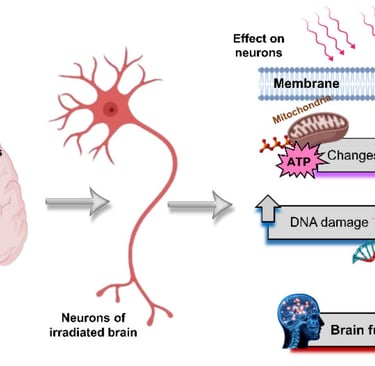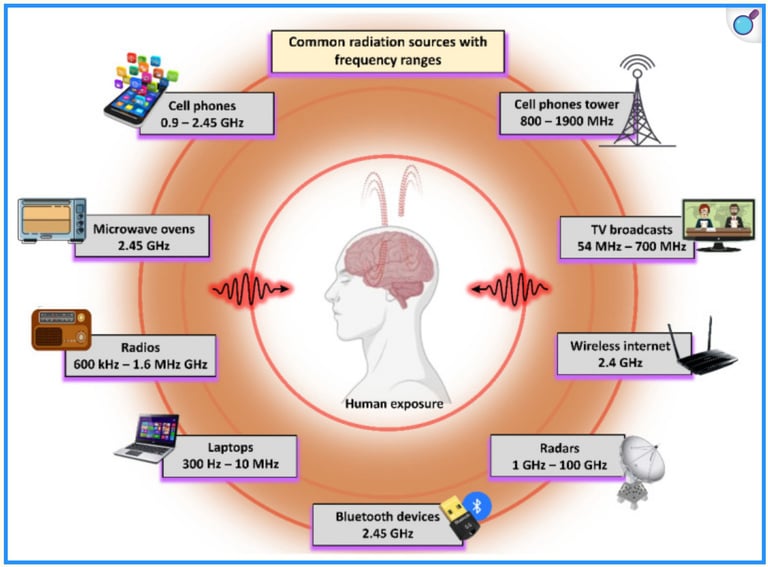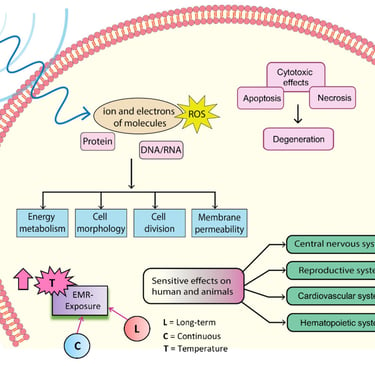Microwave Effects on the Human Body
Microwave Radiation and the Brain: Mechanisms, Current Status, and Future Prospects, Citation: Mumtaz, S.; Rana, J.N.; Choi, E.H.; Han, I., Int. J. Mol. Sci., Published Aug 18, 2022, https://pmc.ncbi.nlm.nih.gov/articles/PMC9409438/pdf/ijms-23-09288.pdf
Figure 1. Depiction of daily commercial and household radiation sources with corresponding operational frequency ranges.
Figure 2. A generalized representation of the interactions between EMR and biological systems, with common effects. The EMR has an impact on molecular ions and electrons, as well as ROS, protein, and DNA/RNA levels. Furthermore, the EMR has cytotoxic effects on cells by causing degeneration, apoptosis, and necrosis. EMR has a strong impact on the central nervous system, reproductive system, cardiovascular system, and hematological system. Furthermore, the constant and long-term exposure of EMR to a biological system raises tissue temperature, which is a frequent effect of different stimuli.
I have put the Introduction here for you to get interested and then go to the original article. There are more illustrations.
1. Introduction.
Microwaves are recognized as nonionizing radiation, with a broad frequency spectrum ranging from 300 MHz to 300 GHz. Specifically, the bands from 300 MHz to 3 GHz are UHF (ultra-high-frequency), 3–30 GHz are SHF (super-high-frequency), and those from 30 to 300 GHz are EHF (extremely high-frequency). Additionally, microwaves that exceed a peak power of 100 MW with an operation frequency lying between 1 to 300 GHz are generally considered high-power microwaves (HPMs). HPMs are commonly employed in modern technologies, and have been proven to be indispensable in our lives, with uses in the commercial, military, and medical fields [1 –4]. Pulse microwave sources and non-pulse microwave sources are the two types of HPM sources available. A microwave source with a rising edge of sub-nanoseconds or picoseconds is referred to as a pulsed microwave source.
A primary drive (explosive or pulse generation system), a pulse compression system, a microwave generation source, and an antenna are all included. Through low-speed storage and fast release of energy, pulse sources typically transform energy into short-pulse EMR.
Radio waves are electromagnetic waves that range from 3 kHz to 300 GHz in frequency. To observe astronomical objects, radio waves are commonly employed as envelope signals on radio communication and wavelength channels. Microwaves are a form of short-frequency radio waves. They can be categorized as a radio wave subclass. Microwaves have a frequency range of 300 MHz to 300 GHz. Microwaves are commonly employed in microwave ovens because resonance frequency of water molecules is in the microwave range. Radars, astronomy, navigation, and spectroscopy all employ microwaves. Accordingly, the development of advanced electronics and novel microwave-based systems has made microwaves an important part of our daily lives. More specifically, the increasing number of radio-wave-based applications has led to the investigation of their biological effects. In the following review, the possible mechanisms and interactions of radiations with biological systems are synthesized.


Figure 6. Representation of microwave radiation effects on the brain. Microwave radiation induces protein damage in neurons, changes mitochondrial activity by influencing the formation of ROS and ATP levels, and causes breaks in single- and double-strained DNA, which leads to brain dysfunction and declines in spatial memory.
Effects of microwave radiation on brain energy metabolism and related mechanisms, Yan-Hui Hao 1, Li Zhao 1,✉, Rui-Yun Peng 1, Mil Med Res, . 2015 Feb 17;2:4. https://pmc.ncbi.nlm.nih.gov/articles/PMC4440565/pdf/40779_2015_Article_33.pdf
Abstract
With the rapid development of electronic technologies, anxiety regarding the potential health hazards induced by microwave radiation (MW) has been growing in recent years. The brain is one of the most sensitive target organs for microwave radiation, where mitochondrial injury occurs earlier and more severely than in other organs. Energy metabolism disorders do play an important role during the process of microwave radiation-induced brain damage. In this paper, we will review the biological effects of microwave radiation, the features of brain energy supply and consumption and the effects of microwave radiation on mitochondrial energy metabolism and potential related mechanisms.
Compound exposure of 2.8 GHz and 9.3 GHz microwave causes learning and memory impairment in rats, Liu Sun, et al., Anhui Medical University School of Basic Medicine, Hefei, 230032, China, Beijing Institute of Radiation Medicine, Beijing, 100850, China, https://www.cell.com/action/showPdf?pii=S2405-8440%2825%2900005-2
Write your text here...
Join us in advocating against harmful technology misuse.
contact@targetedhumans.org
© 2025. All rights reserved.
Targeted Humans Inc.



